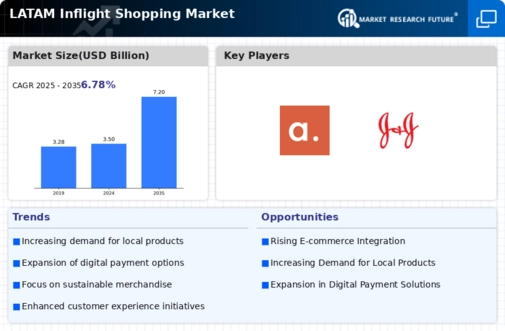Market Analysis
In-depth Analysis of LATAM Inflight Shopping Market Industry Landscape
The market dynamics of the LATAM inflight shopping sector present an intriguing landscape influenced by various factors such as passenger demographics, airline policies, economic conditions, and changing consumer preferences. Inflight shopping refers to the retail opportunities available to passengers while they are onboard an aircraft, offering a range of products from cosmetics and fragrances to electronics and souvenirs. One significant driver of this market is the growing number of air travelers in the Latin American region, spurred by increased tourism, business travel, and improved connectivity. As more passengers take to the skies, airlines and inflight retailers capitalize on this captive audience to generate additional revenue through inflight sales.
Airlines play a central role in shaping the dynamics of the LATAM inflight shopping market. They determine the onboard retail offerings, establish pricing strategies, and manage partnerships with inflight retail providers. Some airlines may opt for a traditional duty-free model, offering a selection of tax-free goods to passengers, while others may focus on curated product offerings tailored to their target demographics. Additionally, airlines may leverage inflight entertainment systems, seatback catalogs, and cabin crew promotions to promote inflight shopping and drive sales. The inflight shopping experience is closely tied to the overall passenger experience, with airlines striving to enhance onboard retail offerings to differentiate themselves and increase customer satisfaction.
Economic conditions and currency fluctuations also impact the LATAM inflight shopping market. As disposable incomes rise and fall, passenger spending habits may change, affecting the demand for inflight retail products. Currency devaluations or economic downturns in certain countries can impact purchasing power, influencing passenger willingness to make inflight purchases. Moreover, regional disparities in economic performance and consumer confidence levels may result in variations in inflight shopping trends across different Latin American markets. Airlines and inflight retailers must monitor these economic factors closely and adjust their strategies accordingly to optimize revenue generation from inflight sales.
Changing consumer preferences and shopping behaviors further contribute to the dynamic nature of the LATAM inflight shopping market. With the rise of e-commerce and digital retail platforms, passengers have become accustomed to convenient and personalized shopping experiences. In response, airlines and inflight retailers are exploring innovative ways to digitize the inflight shopping experience, such as offering pre-order options, mobile app integration, and personalized recommendations based on passenger profiles. Additionally, sustainability and ethical sourcing are increasingly important considerations for consumers, driving demand for eco-friendly and socially responsible products in the inflight retail space.
Competition within the LATAM inflight shopping market also influences market dynamics. Airlines and inflight retailers vie for passengers' attention and spending by offering compelling product selections, competitive pricing, and promotional incentives. Strategic partnerships with brands and suppliers enable airlines to access exclusive products and enhance their inflight retail offerings, while inflight retailers leverage their expertise in merchandising and marketing to maximize sales opportunities. Furthermore, the emergence of low-cost carriers and new entrants in the aviation industry introduces additional competition, challenging established players to innovate and adapt their inflight shopping strategies to remain competitive





Leave a Comment